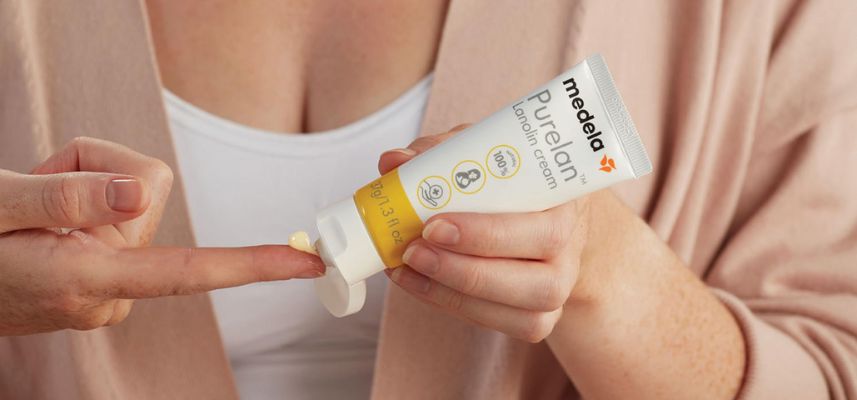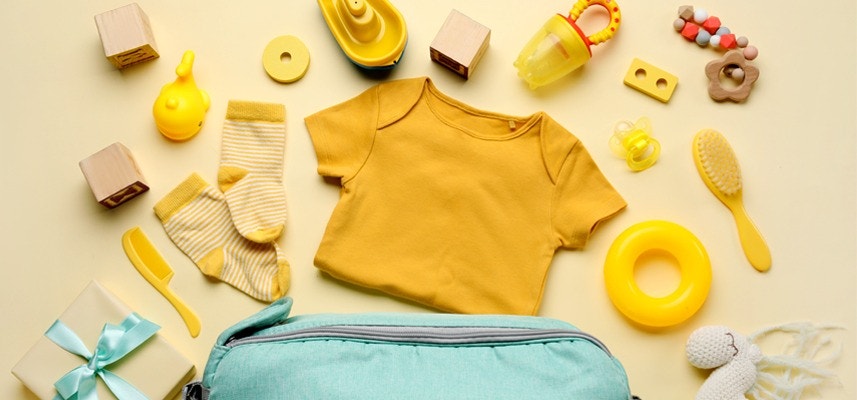Key Takeaways:
-
Nipple cream helps soothe, protect, and heal sore or cracked nipples during breastfeeding
-
Lanolin-based creams and plant-based balms are both effective options for nursing mothers
-
Most nipple creams are safe for your baby and don't need to be removed prior to feeding
-
You can start using nipple cream as soon as you experience discomfort
While the breastfeeding experience can be incredibly rewarding, it may also come with some challenges, including sore nipples.
Sore nipples are one of the most common challenges new moms face, especially in those first few weeks as you and your baby figure out breastfeeding together. Fortunately, nipple creams and balms can offer real relief. These products are designed to soothe irritation, protect sensitive skin, and help your nipples heal so you can keep your breastfeeding journey on track.
This guide will help you understand how nipple creams work, how to choose the right one, and how to use them effectively.
What Does Nipple Cream Do?
Think of nipple cream as first aid for your nipples. When you're breastfeeding or pumping many times a day, your delicate skin goes through a lot. Nipple cream creates a barrier that protects sore nipples.
Many nursing mothers experience soreness, cracking, or even bleeding, especially during the early days when trying to establish a good latch. Nipple cream helps by:
-
Soothing irritation and nipple pain
-
Protecting sensitive nipples from further damage
-
Promoting quick healing of cracked skin
-
Reducing friction during pumping sessions
-
Keeping skin moisturized to prevent dryness
The right nipple cream can make the difference between pushing through discomfort and actually enjoying those quiet feeding moments with your baby.
When Should I Start Applying Nipple Cream?
Start applying nipple cream at the first sign of soreness or discomfort. Nipple cream can provide instant relief and help prevent minor irritation from turning into cracked nipples or more serious irritation. The first few weeks of breastfeeding are when your nipples are most vulnerable, so having nipple cream on hand—and using it liberally—is a smart move.


Types of Nipple Cream: Lanolin vs. Plant-Based Options
Not all nipple creams are created equal, and what works for your best friend might not work for you. The two main categories are lanolin-based creams and plant-based balms.
Lanolin Nipple Cream
Lanolin is derived from sheep's wool and has been the holy grail for nursing mothers for decades. It's incredibly effective at creating a long-lasting protective barrier and promoting healing for cracked nipples.
Lansinoh Lanolin Nipple Cream is a well-known nipple cream. This single-ingredient product contains 100% HPA-modified lanolin that goes through a unique purification process to ensure it's hypoallergenic and safe for sensitive skin.
Medela Purelan Lanolin Cream is another popular choice among breastfeeding moms. This medical-grade cream contains 100% ultra-pure lanolin. It's ethically sourced, hypoallergenic, and forms a thick protective layer that helps promote healing when nipples have deep abrasions.
Both lanolin creams are quite thick, so some moms prefer to wipe off excess before breastfeeding, though it's not necessary.
Plant-Based Nipple Balms and Butters
For moms who prefer organic, vegan, or lanolin-free products, plant-based nipple balms offer excellent alternatives. These creams typically contain ingredients like coconut oil, extra virgin olive oil, shea butter, cocoa butter, calendula flower, and aloe.
Willow Nipple Balm is a lightweight, non-greasy option made with premium vegan ingredients and no fragrance, phthalates, preservatives, or parabens. It's lanolin-free and provides soothing relief without the thickness of lanolin-based creams. It also doubles as a lubricant on breast pump flanges to provide a more comfortable pumping session.
Earth Mama Nipple Butter is another beloved plant-based choice. This organic nipple balm is certified cruelty-free and made by a company that's been supporting new parents for years.
Plant-based nipple balms tend to be thinner than lanolin creams, which some moms find more comfortable for everyday use.
So, What's the Best Cream for Nipples?
The best nipple cream is the one that works for your skin and your situation. Lansinoh Lanolin is the gold standard recommended by lactation consultants, but that doesn't mean it's automatically the right choice for everyone.
If you have severely cracked nipples, the thick protective barrier of lanolin-based creams might give you the intense moisture and healing you need. If you're dealing with mild soreness or prefer lighter textures, a plant-based balm like Willow or Earth Mama might be more your speed.
Some moms even use different products for different situations: lanolin after pumping when they need maximum protection and a lighter balm throughout the day for comfort. Listen to your body, and don't be afraid to try a few options until you find what feels best.
Is Nipple Cream OK for Babies?
Yes! All the nipple creams we've mentioned—Lansinoh Lanolin, Medela Purelan, Willow Nipple Balm, and Earth Mama Nipple Butter—are all safe for your baby. They're specifically formulated for breastfeeding mothers, which means they're made with ingredients that won't harm your little one during nursing.
Do You Have to Wipe Nipple Cream Off Before Breastfeeding?
Nope! One of the best things about quality nipple creams is that they're safe to leave on during feedings. You don't need to wash or wipe your nipples before nursing.
In fact, constantly removing and reapplying cream can actually disrupt the healing process. The whole point of nipple cream is to create a continuous protective barrier, and that works best when you let it do its job.
The only exception might be if you've applied a very thick layer of lanolin-based cream and prefer to remove some of the excess before your baby latches. But even then, it's about your comfort, not safety. These creams are designed to stay put without causing any issues for you or your baby.
Can I Use Vaseline as Nipple Cream?
Petrolatums like Vaseline and Aquaphor are household staples and might seem like easy solutions for sore nipples, but they're not the best choice for breastfeeding. These products do create a protective barrier for your skin, but they aren't formulated to be ingested by babies and would need to be removed prior to feedings, possibly causing more irritation or damage.
Instead, stick with nipple creams and balms made specifically for breastfeeding. They're clinically tested, designed for sensitive nipples, and safe for your baby to ingest. Plus, many contain additional nourishing ingredients to actively support healing.


How to Apply Nipple Cream
Using nipple cream effectively doesn't require a special technique, but a little guidance can help you get the most out of your product.
After breastfeeding or pumping, there's no need to wipe your nipples clean. Breast milk actually has healing properties, and leaving a little on your skin is beneficial. Let your nipples air-dry for a couple of minutes, then take a pea-sized amount of cream and gently apply it to any sore or damaged areas. If it feels especially thick or sticky, try warming a small amount between your fingertips first. This softens the cream and makes it easier to spread comfortably.
You don't need to cover your entire nipple and areola. Just focus on the spots that need attention. And there's no need to rub the cream in completely, especially with thicker lanolin products. Just let it sit on the skin and create that protective barrier.
As for how often to apply, use nipple cream as needed throughout the day. Aeroflow Breastpumps expert Liz Truesdale explains, "Many nursing moms find it helpful to apply nipple cream after each feeding session, but you can also use it between feedings if you're experiencing ongoing discomfort. The key is listening to your body and giving your nipples the care they need."
Nipple Care Tips Beyond Cream
While nipple cream is a great solution, it works best as part of a comprehensive approach to nipple health. Here are some additional tips to keep your nipples comfortable during your breastfeeding journey:
Get the Latch Right: The most important thing you can do to prevent nipple pain is ensure your baby has a proper latch. If you're struggling with latch issues or persistent soreness even with nipple cream, reach out to a lactation consultant for personalized support.
Let Your Nipples Breathe: After feeding sessions, let your nipples air-dry for a few minutes before applying cream and putting your bra back on. This allows your skin to breathe for a bit before you form a protective moisture barrier with nipple cream.
Watch for Signs of Irritation: No matter what product you use (lanolin cream or nipple balm), keep an eye on your nipple and the surrounding skin. If you notice increasing redness, heat, or pain, contact your healthcare provider. Sometimes what seems like simple soreness can actually be an infection that needs medical attention.
Consider Additional Products: If you're dealing with particularly painful nipples, breast shells worn between feedings can create a protective space that prevents friction from your clothing. For moms with flat or inverted nipples, nipple everters can help draw out the nipple before feeding to support a better latch.
What Skin Care Should I Avoid When Breastfeeding?
When you're breastfeeding, you want to be thoughtful about what you put on your breasts and nipples. Avoid using heavily fragranced lotions, harsh soaps, or products with ingredients you wouldn't want your baby ingesting. Skip anything with retinoids or other active ingredients meant for facial skin care.
Your breast skin is different from the skin on the rest of your body, and your nipples in particular are delicate and permeable. Stick with products specifically designed for nursing mothers, or keep it simple with gentle, fragrance-free options.
And while it might seem like your lip balm could double as a nipple balm, lip balms often contain ingredients like menthol or camphor that aren't ideal for nursing. Use products made for breastfeeding instead.
Alternative Uses for Nipple Cream
On the other hand, many moms use their nipple creams to address other dry skin issues. Lanolin and plant-based balms can soothe dry lips, cracked heels, dry skin patches, and even minor skin irritation. Just remember to use separate tubes for different body parts.


We're Here to Support You
Remember, every mom's breastfeeding journey is unique. What works perfectly for one mom's sensitive skin may not be the best solution for yours. That's why it's essential to be patient with yourself, stay open to trying different options, and reach out for support when you need it.
Nipple cream is incredibly helpful for managing discomfort, but it shouldn't be used to mask underlying issues like poor latch or infections. When in doubt, contact your healthcare provider or seek professional support from a lactation consultant.
At Aeroflow Breastpumps, we're here to help you navigate every part of your breastfeeding and pumping experience. We offer breast pumps and other supplies available through insurance. From latching techniques to fitting your flange, our essential classes also serve as a useful resource for the postpartum period.





